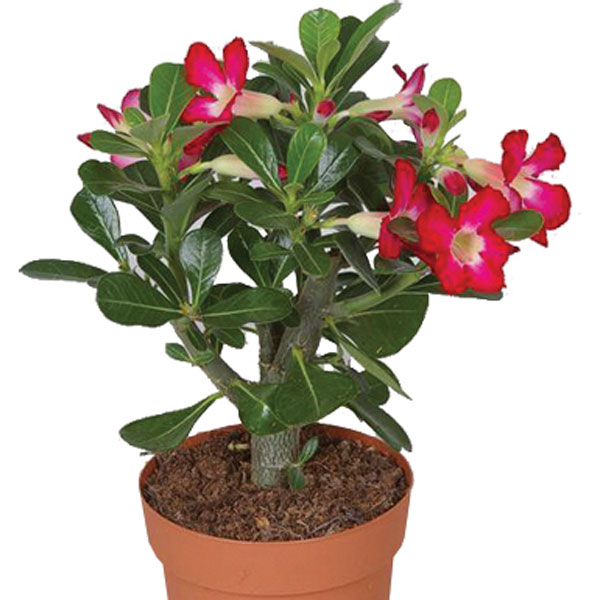Desert Rose Indoors (Adenium obesum)
Features
A most interesting bottle-trunked plant that bears clusters of dainty blooms with little care needed. Use it solo as a centerpiece or interplant with other, lower growing, succulents to create a miniature indoor landscape.
Uses
Useful for interiors, porches, patios or landscapes. Nice for larger patio containers.
Plant Feed
Once every month during active growth in the spring and summer. Do not feed in winter.
Watering
Allow soil to dry between thorough waterings.
Soil
Well-drained, slightly alkaline soil.
Planting Instructions
If the plant was purchased in a pot, then it is probably already in a quality potting soil and requires little more than watering and grooming for a while.
If potting a flowering plant to bring indoors or to give as a gift plant, start with a good quality, commercial potting soil. These are usually lighter in weight than topsoil, sterile and pest-free. Many are available with a mild starter fertilizer in the mix.
Select a container with a drainage hole or be prepared to drill holes for drainage if there are none.
Prepare the container by filling with potting soil up to 2” (5cm) from the rim of the planter. Make a small hole in the soil slightly larger than the root ball either by hand or using a trowel. Insert the plant into the hole and press soil firmly around the roots and just covering the root ball. When all the plants are potted, water thoroughly to settle the soil and give plants a good start. Place plant in bright location for best performance.
Repot every 2 years in the same container or in a container slightly larger than the diameter of the roots.
Watering Instructions
Most potted flowering plants prefer consistently moist but well-drained soil. If the soil gets too dry the blooms can wilt and they may not recover. Check the soil moisture with your finger. If the top 2-4” (5-10cm) of soil is dry, or plants are wilted, it is time to water.
Apply water at the soil level if possible to avoid wetting the foliage. Water the entire soil area until water runs out the base of the pot. This indicates that the soil is thoroughly wet.
Fertilizing Instructions
Fertilizers are available in many forms: granulated, slow-release, liquid feeds, organic or synthetic. Determine which application method is best for the situation and select a product with a nutritional balance designed for foliage plants.
Too much fertilizer can damage plants so it’s important to follow the package directions to determine how much, and how often, to feed plants.
Slow-release fertilizers are an especially good, care-free choice for container plants. Follow the product directions for proper timing and application rates.
Pruning Instructions
Remove the flowers as they fade. This keeps the plant looking tidy and may encourage more blooms depending on the type of plant. After flowering many blooming plants make attractive houseplants. Be sure to trim the foliage to maintain the desired size and shape. Occasional trimming encourages the plant to develop more side-shoots and flowers, and reduces the demand for the plant to develop a larger root system. This is important since the roots are in a confined space.
Some plants will re-bloom on their own, but others may have very specific day-length or temperature requirements to flower again. A bit of research may be necessary to determine what is needed to encourage future blooming. Some plants, such as bulbs or perennials, can be turned into wonderful garden additions after the flowers have been enjoyed indoors.
Plant Details
| Available Colors: | Red, White, Pink |
| Bloom Time: | Year round |
| Height Range: | 1-4' (0.3-1.2m) |
| Space Range: | 18-24" (46-61cm) |
| Temperature Range: | 60° to 80°F (16° to 27°C) |
| Plant Light: | Bright Light |
| Companion Plants: | Dracaena, Aglaonema, Philodendron Totem |
Availability
- Jan
- Feb
- Mar
- Apr
- May
- Jun
- Jul
- Aug
- Sep
- Oct
- Nov
- Dec



